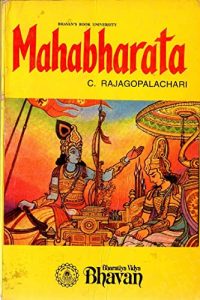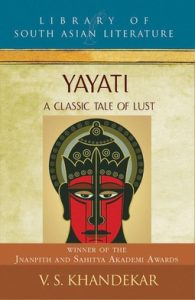I am reading C Rajagopalachari’s Mahabharata again after more than twenty years. This is the abridged prose version of the epic Sanskrit poem: at 1.8 million words, the longest in the world, with countless retellings and adaptations across millennia. Although the historicity of the Mahabharata is still being worked out, the story is set in North India in the millennia before the common era.
I chose to revisit the Mahabharata to alter my reading habits a bit. I’ve been absorbed with Western books on natural history, biology and science in the last few years. They have helped me look at the world in a completely new light. But I also felt the need to read something with a totally different worldview — at least something outside the bubble of Western science. So, as I flew to Bangalore, India, to be with my parents for a few weeks this winter break, I decided to take the Mahabharata along. My parents are devout Hindus and their 9th story flat is so full of images of the deities they worship and the television they watch is so full of commentaries of old Hindu texts, that the milieu of the Mahabharata fits seamlessly here.
Ninety odd pages in, I am really enjoying it. The stories in the book seem charged with a deeper meaning, now that I am much older than when I first read them. Each chapter features a character, sub-plot or theme, with a clearly defined beginning and end. Yet each chapter also fits into the larger narrative of dynastic conflict and war between two groups of cousins: the Pandavas and Kauravas.
In addition to the primary cast — Bhishma, Kunti, Drona, Duryodhana, Krishna, Arjuna, Bhima, Draupadi: all household names in India — dozens of fleeting characters come and go, playing small but important roles. There are forest sages with yogic powers who can foretell the future and deliver powerful curses (and yet soften their impact if sincere pleas are made). There are celestial deities, demons and monsters who seem quite apart from humans in their special abilities but still remain very human in their desires and foibles. The chain of cause and effect — actions at one time resulting in karmic consequences in another — is a recurring theme throughout. The stories involve exceptional acts of generosity and sacrifice but deceit, long-standing grudges and a yearning for revenge play an equally important role. In fact, it is the vices, which most characters succumb to, that make the Mahabharata so interesting.
§
One of my favorite stories is of a king named Yayati, an ancestor of the Pandavas and Kauravas. Yayati marries Devyani, the daughter of a famous sage named Sukracharya (Devyani has her own chapter in the book and an equally fascinating story). Without telling Devyani, Yayati secretly also marries Devyani’s attendant, Sarmishta. Devyani is naturally distraught when she finds out. Her furious father Sukracharya curses Yayati with premature old age which takes immediate effect.
Shocked, Yayati begs Sukracharya to remove the curse. Sukracharya says that the curse has to take its course, but relents that if Yayati “can persuade anyone to exchange his youth for your age the exchange will take effect”. Yayati desperately wants his youth back since he is “still haunted by the desire for sensual enjoyment”. He still wants to enjoy the company of women. He turns to his five sons, and this is what he asks them:
“The curse of your grandfather has made me unexpectedly and prematurely old. I have not had the fills of the joys of life… One of you ought to bear the burden of my old age and give his youth in return. He who agrees to this and bestows his youth on me will be the ruler of my kingdom. I desire to enjoy life in the full vigor of youth.”
What an extraordinary request — of course no one wants to give their youth away even if a kingdom is received in return! The first four sons refuse. But, in an astonishing act of selflessness, the youngest son Puru agrees to his father’s request. Moved and delighted, Yayati embraces Puru and immediately finds that his youth is back while Puru has turned old. He tells is son he will “enjoy life for just a while more and then give you back your youth.”
Yayati indulges himself for many years. He spends time with a beautiful woman (an apsara) in an exotic location (Garden of Kubera). But after years and years of trying of fulfill his sexual desires, there’s a key moment when he realizes that repeated gratification has not helped him. He returns to Puru with this realization:
“Dear son, sensual desire is never quenched by indulgence any more than fire is by pouring ghee on it. I had heard and read this, but till now I had not realized it. No object of desire — corn, gold, cattle or women — nothing can ever satisfy the desire of man. We can reach mental peace only by a poise beyond likes and dislikes. Such is the state of Brahman. Take back your youth and rule the kingdom wisely and well.”
Yayati retires to the forest to lead a simple life of austerities. The chapter, thus, ends with a well known teaching of Indian spiritual traditions: that one must develop the wisdom to not run after sense pleasures. The interesting part is that Yayati was quite aware of this, yet simply hearing or reading about it did not compel him to act differently. Only repeated experience — seeking gratification again and again and failing to find anything substantial or lasting — convinced him. Perhaps the true message of Yayati’s story, then, is that there is no short-cut to such realizations, that the path can be long and convoluted.
§
An interesting footnote: A few days after publishing this post, I was browsing at a bookshop in Bangalore when I stumbled upon a novel by V.S. Khandekar titled Yayati. This chance encounter with Khandekar’s novel — just a few days after publishing this post — belongs to the department of interesting coincidences! (Much like how I saw a slug for the first time in Amherst, a few days after reading Elizabeth Tova-Bailey’s The Sound of a Wild Snail Eating.) It turns out that Yayati is a classic of Marathi literary fiction in which Khandekar re-imagines and elaborates on the story through different first-person narratives.

